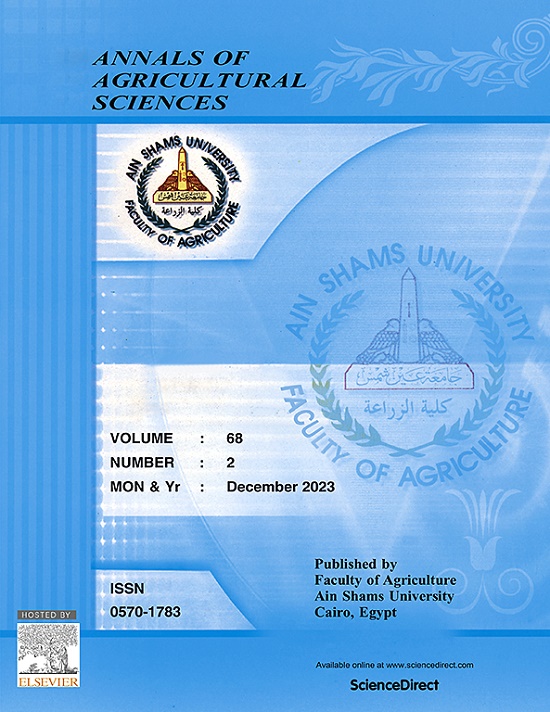独角蜜内酯通过改善玉米叶绿体保护、气孔功能和抗氧化防御机制缓解干旱胁迫
IF 3.2
2区 农林科学
Q1 AGRICULTURE, MULTIDISCIPLINARY
引用次数: 0
摘要
植物激素及其衍生物是调控植物抵抗非生物胁迫的信号网络的重要组成部分。一类新的类胡萝卜素衍生的植物激素,独角酯内酯(SLs),已被证明可以调节干旱胁迫(DS)下植物的各种生理化学过程。本研究通过优化SLs浓度来减轻DS对玉米幼苗的有害影响,提出了独特的研究结果。由于活性氧(ROS)的过量产生,干旱胁迫显著降低了植物的生长属性和叶片叶绿素色素。叶面施用SLs改善了叶片的生长性状、叶绿素含量、光合速率和气孔性状,同时显著降低了氧化损伤,过氧化氢(H2O2)、超氧化物(O2−)和丙二醛(MDA)含量显著降低(p≤0.05)。此外,DS + SL3处理显著改善了叶片超微结构,降低了叶片氧化损伤,H2O2、O2−和MDA含量分别降低了32.49%、33.31%和55.23% (p≤0.05)。超氧化物歧化酶(SOD)、过氧化物酶(POD)、过氧化氢酶(CAT)和抗坏血酸过氧化物酶(APX)活性分别提高了31.64%、49.61%、53.18%和101.35%。独角孤内酯增强了叶绿体结构,支持细胞扩张,保护细胞壁,显著改善气孔数量、长度和宽度等性状。这些结果表明,叶面施用SLs可以通过上调叶绿素色素和激活抗氧化防御机制来减轻干旱胁迫的不利影响,从而减轻ROS的损害。本文章由计算机程序翻译,如有差异,请以英文原文为准。
Strigolactones mitigate drought stress in maize by improving chloroplast protection stomatal function and antioxidant defense mechanisms
Phytohormones and their derivatives are essential components of the signaling networks that regulate plant defense mechanisms against abiotic stress. A novel class of carotenoid-derived plant hormones, strigolactones (SLs), has been shown to modulate various physiochemical processes in plants under drought stress (DS). This study presents unique findings by optimizing the concentration of SLs to mitigate the detrimental effects of DS on maize seedlings. Drought stress significantly reduced plant growth attributes and leaf chlorophyll pigments due to excessive production of reactive oxygen species (ROS). The foliar application of SLs improved growth attributes, chlorophyll content, photosynthetic rate, and stomatal traits, while significantly reducing oxidative damage, as evidenced by a decrease in hydrogen peroxide (H2O2), superoxide (O2−) and malondialdehyde (MDA) content (p ≤ 0.05). Furthermore, the DS + SL3 treatment significantly improved leaf ultrastructure and reduced oxidative damage, as evidenced by decreases in H2O2, O2− and MDA content by 32.49 %, 33.31 %, and 55.23 % (p ≤ 0.05) respectively. This treatment also increased the activities of antioxidant enzymes, including superoxide dismutase (SOD), peroxidase (POD), catalase (CAT), and ascorbate peroxidase (APX) by 31.64 %, 49.61 %, 53.18 %, and 101.35 %, respectively. Strigolactones enhanced chloroplast structure, supported cell expansion, protected cell walls, and significantly improved stomatal traits, including number, length, and width. These findings suggest that the foliar application of SLs can mitigate the adverse effects of drought stress by upregulating chlorophyll pigments and activating antioxidant defense mechanisms to mitigate ROS damage.
求助全文
通过发布文献求助,成功后即可免费获取论文全文。
去求助
来源期刊

Annals of Agricultural Science
AGRICULTURE, MULTIDISCIPLINARY-
CiteScore
12.60
自引率
0.00%
发文量
18
审稿时长
33 days
期刊介绍:
Annals of Agricultural Sciences (AOAS) is the official journal of Faculty of Agriculture, Ain Shams University. AOAS is an open access peer-reviewed journal publishing original research articles and review articles on experimental and modelling research at laboratory, field, farm, landscape, and industrial levels. AOAS aims to maximize the quality of the agricultural sector across the globe with emphasis on the Arabian countries by focusing on publishing the high-quality applicable researches, in addition to the new methods and frontiers leading to maximizing the quality and quantity of both plant and animal yield and final products.
 求助内容:
求助内容: 应助结果提醒方式:
应助结果提醒方式:


